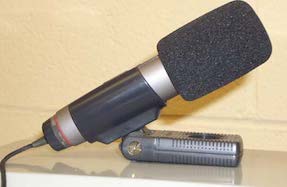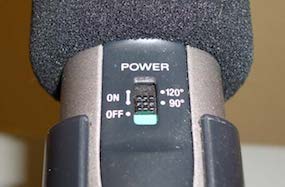Please do not use the built in microphone on any device you choose to record audio with. The exceptions to this are the recorders we recommend such as the Zoom H2n and the Tascam DR-05 which have good built-in microphones. The microphones that come built in to most devices are of inferior quality.
The first thing to understand about microphones is that, in general, there are two types: omni-directional and directional (a.k.a. cardioid). Omni-directional microphones are to be avoided. As the name suggests, they pick up sound in all directions which is not what you want when recording audio for transcription. What you do want is the person who is to be transcribed (the subject of your audio recording) to be recorded with as little other extraneous sound as possible.
This is partially accomplished using a directional microphone often referred to as a ‘Shotgun Microphone’ or ‘Supercardiod pattern’. A directional microphone will pick up sound most clearly in the direction it is pointed while limiting the recording of other audio. Here is a visual representation and brief tutorial on microphone patterns.
Irrespective of what device you use to record your audio, a decent directional microphone can improve the quality of the audio captured.
The Sony ECM-MS907 Stereo Microphone is a good choice for interviews as it allow you to select how directional the microphone will be, ‘tight’ for single person interviews, ‘open’ for groups. (It can be purchased for between $80 and $100.). We recommend setting it to 90 degrees when recording interviews.
A good choice for a video camera microphone is the Rode VideoMic Directional Shotgun Mic. It is about $230, can mount directly onto most consumer video cameras and is considered a shotgun microphone (highly directional).
Another good option for fixed location interviews is to use a Lav Microphon (aka lapel microphone). It will attach to the collar of the person being interviewed. Here’s one relatively inexpensive option: Audio-Technica ATR-35S Lavalier Microphone
Often times on professional productions, both a Lav and a Shotgun microphone will be deployed. That way the bases are covered.
Sony ECM MS-907 microphone for transcription recording. |
|
|---|---|
Side View |
Top View |
 |
 |
| We recommend using the 90deg setting for most interviews. This will help attenuate extraneous noise. | |
Microphone Placement
Once you have a separate microphone, it is important to place it as close to the person being interviewed as possible. Microphones operate under the Inverse-Squares rule. Simply stated, every doubling of the distance reduces the sound level by a power of 2. Thus a speaker 4 feet from the microphone will only be 1/4 as loud on the recording as the same speaker 2 feet from the microphone. We recommend that you try to place the microphone directly in front of the person talking no more than 2 feet away. Be sure to point the microphone directly at the person talking.
Recording Environment
Try to record your audio in a quite environment. Recording your interviews in a crowded shopping center is not an ideal environment. Be careful to avoid noise that you might not normally notice. For example recording under an air- conditioning unit or by an open window overlooking the freeway should be avoided if possible.
Remember, your brain will ‘filter’ out the extra sound while your are on location, but the recording device will capture all the sound. Thus, while you can understand what is being said while standing next to the jackhammer, once you listen to the tapes later, it will be much more difficult because your brain will not be able to filter out that sound as easily after the fact.
If you are forced to record in a noisy environment, try to place the microphone as close to the subject as possible. (inches as opposed to feet.) You may have noticed how TV sports reporters stick the microphone right up to their subject’s mouths. This allows them to get the subject nice and loud and the screaming fans can’t be heard. (It’s an application of the Inverse-Squares rule mentioned above. A microphone inches from the mouth makes that person many times louder than people even only 3 or 4 feet away.)